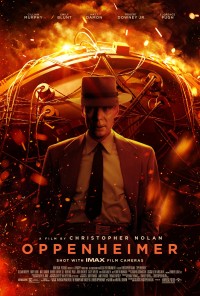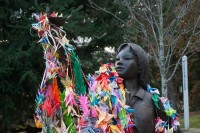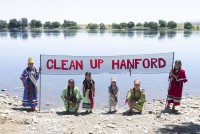Insight on Victims of Nuclear Weapon Use
We need to talk about Oppenheimer.

This summer, the film Oppenheimer is sparking new interest in the Manhattan Project and prompting questions about the impact and legacy of nuclear weapons use, nuclear weapons testing, and the production of uranium and plutonium. The film entirely omits the voices of people directly impacted by the fallout, contamination, and devastating violence of nuclear weapons use and production.
The resources below provide just a few insights into the experiences of Tribal people, nearby communities, and victims of nuclear weapons use, and they are by no means exhaustive. The leaders, writers and commenters linked below courageously speak to the immense harm and suffering caused by the U.S.’ nuclear weapons program. Their work is central to healing the damage that continues at places like the Hanford Nuclear Site on the Columbia River, the most contaminated place in the Western Hemisphere.

Atomic Bomb survivors are referred to in Japanese as hibakusha. You can read first-hand accounts and reflections of hibakusha at Hibakusha Stories. According to the website, the focus of Hibakusha Stories is to employ the testimony of Hiroshima and Nagasaki survivors, Indigenous Peoples, Downwinders, nuclear test survivors and other affected communities to take action for disarmament. Hiroso Iso writes,
"I was exposed to the atomic bomb at the age of four, about 2.5 kilometers away from the hypocenter in Hiroshima. My father, mother, older sister, younger brother and I were living there. On August 6th, 1945, it was a beautiful morning. At 8:15 am, after my father and my sister already left for work, one nuclear bomb was dropped on us, and instantly, thousands of people were incinerated and the rest were seriously burnt and injured. The city turned into a hell. By the end of 2009, an estimated death toll due to Hiroshima nuclear bomb reached 140,000."
Iso’s is one of dozens of accounts of hibakusha at Hibakusha Stories.
The Guardian recently featured the experience of Yakama Nation leaders who were forced to leave the Hanford Nuclear Site, as well as Yakama Nation staff who are working to address contamination at Hanford. The story, “Nuclear waste ravaged their land. The Yakama Nation is on a quest to rescue it,” explains,
LaRena Sohappy, 83, vice-chairwoman for Yakama Nation General Council, whose father was a well-known medicine man, grew up in Wapato, about 40 miles from Hanford. Her cousin’s family who lived close to Hanford were woken in the middle of the night and forced to leave to make way for the nuclear site, she recalled, “They didn’t have time to pack up anything,” said Sohappy. “They just had to leave and they were never told why and how long they were going to be gone.”
Oppenheimer entirely omitted the experience of Tribal people who were forced away from Hanford and experienced decades of pollution and health harms from the vast radioactive contamination at Hanford.
Hanford remains the most contaminated place in the Western Hemisphere, requiring decades more of cleanup.
As Samantha Redheart, who coordinates Science Technology Engineering and Math programs for Yakama Nation’s ERWM program told The Guardian, “We always share that Hanford is a multi-generational cleanup site…Yakama Nation leaders and management are always looking into not just the cleanup today, but for our future generations and of our children that are not yet born.”
To learn about more communities impacted by nuclear weapons, check out part 2 of this blog.



